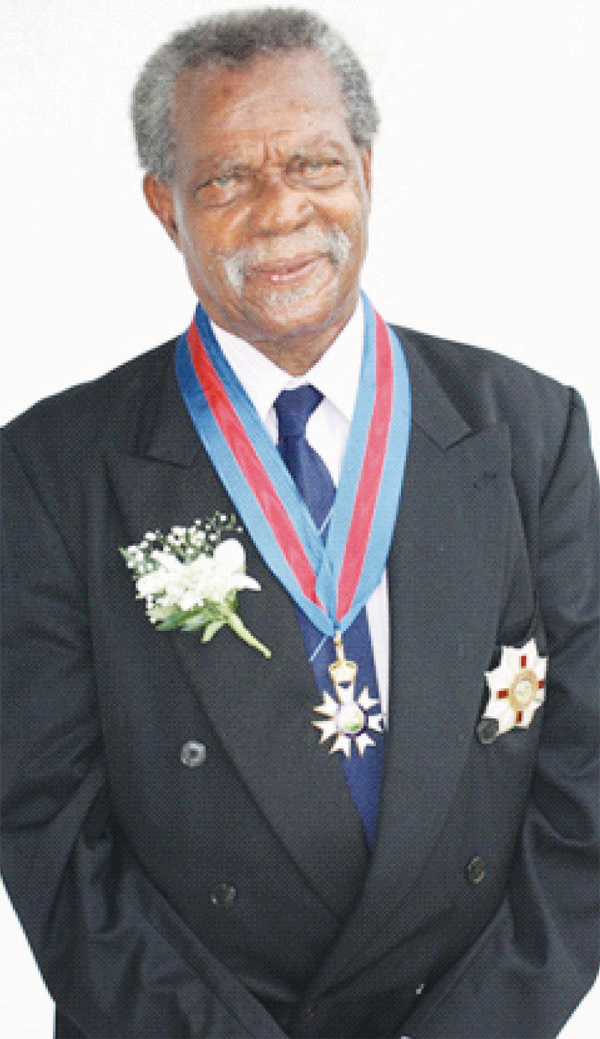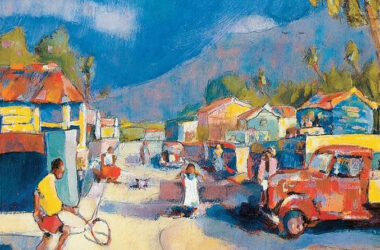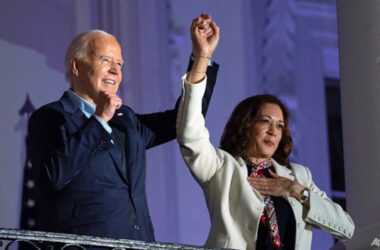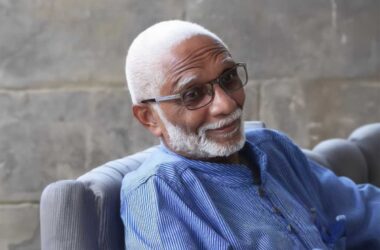
When my editor, asked me sometime in January 2015 whether I was planning to contribute any content to our paper’s upcoming Independence supplement, it took me less than five seconds for something along the lines of a Sir Dunstan St. Omer biography to seem appropriate. Right off the bat, I told him that given Sir Dunstan’s failing health at the time, it would be poetic and fitting to retrace his colourful life through his own words and not simply his paint.
Arriving at the St. Omer’s Union residence that hot Sunday afternoon in February 2015, I felt an unnerving sense of trepidation. I mean, I had visited the St. Omers back in January 2010 when it was announced that the artistic giant had been given the nod for a knighthood. That conversation with him and his wife, Cynthia, was as warm and laid-back as the air that blows through my wife’s grandparents’ home on that high hill in Canaries. That was a different time.
The couple, who had been together for most of their lives – Sir Dunstan would later joke that he couldn’t find a better woman and so he had no choice – had felt the knighthood, though fitting, was not necessarily the highlight of their lives. What the art legend was able to contribute to his Maker, family and country still remained paramount.
Ever the funnyman, Sir Dunstan reiterated that the medal meant more to his wife and beloved country that had given him much more than any little Castries ti-wat could ever imagine. Two months later – in March 2010 — when he was named a Saint Lucian icon, Sir Dunstan reminded me to be at Government House the following month to capture his big moment. I couldn’t let him down and I didn’t.
But back to February 2015 when instead of meeting Sir Dunstan formally five years prior I found myself questioning whether I would be fortunate to meet him again. Even though I had made prior arrangements to meet him, Lady Cynthia told me that he was on the verge of chickening out of our interview upon my showing up. After about five minutes, he rolled out into the verandah in his wheelchair, looked straight at me and – like a new LED bulb – his face lit up with that familiar grin.
“You sure you want to interview the old man while he’s in this wheelchair?” he asked.
After pleasantries, we talked about various aspects of his life, including how he was able to come up with the theme for our national flag and how much Fair Helen meant to him. We spoke about his friendships with the likes of Derek and Roderick Walcott, Harold Simmons and Monsignor Patrick “Paba” Anthony.
He took long pauses at times to harvest the correct words but he was nevertheless coherent. We spoke about a lot of things and by the time Sir Dunstan was done, I was convinced that the best way to tell that story was via a question and answer format. Sadly, three months later, the artistic giant went to sleep.
Ever since meeting Sir Dunstan and hearing about his exploits throughout the years, it was clear that he was a man not unlike other talented Saint Lucians who use their gifts for the betterment of all of us. Having personally benefitted from the expertise and inspiration of people like Sir Dunstan, Kendel Hippolyte, Frank Norville, Derek Walcott, Sir Arthur Lewis, Jacques Compton, Adrian Augier, Drenia Frederick and my current editor Guy Ellis, in varying degrees, I can unequivocally say that we have absolutely no excuse for failure.
Many people know Sir Dunstan – or “Apilo” — for his beautiful art. Some do for his high-spirited nature. Some simply know him as the man who designed our national flag. Few know the pains and struggles he and his contemporaries had to endure as they envisaged and worked towards this island shaking off the shackles of colonialism and becoming an “us” country rather than a “those European people’s country”. If one traced his life, Sir Dunstan would have been a pioneer, trailblazer, philosopher, artist, father – and best of all – a man who just would never shut up about his country’s fine qualities and his wife and children’s love.
Obviously, Sir Dunstan was a much-adored and larger-than-life figure. Artists and others feed off his energy. Political figures like to quote him when it suits their purpose. But one of my closest friends, Dagonia Joseph, is an exceptional case. An artist himself, Dagonia’s admiration for Sir Dunstan traces far back, long before the knighthood. I remember that cool afternoon in 2007 at Barre Denis where we lived when Dagonia and I spoke about the ceremony being held at Jacmel church that day when the Folk Research Centre (FRC) declared Sir Dunstan a national cultural hero.
I wasn’t present at the 2007 ceremony but among the things Dagonia and I discussed that day was that greatness can only be achieved when we reach for it, claim it and treasure it. Dagonia and I made a deal that day to pursue our dreams no matter what. Incidentally, just a few months later, I quit my job and became a reporter. As for Dagonia, he quit local businesses giving him the runaround for sale and payment for his artwork, picked up his easel and paintbrushes and now tours the United States participating in art exhibitions. I guess things like that happen when you let people like Sir Dunstan into your conversations. To this day, Dagonia is amazed that we did it; I’m not.
One of the last things Sir Dunstan told me in February 2015 when we last met was that there’s a bright future for all of us. When I asked him what message he had for Saint Lucians as we prepared to usher in the island’s 36th independence anniversary, he seemed more than ready to paint the path to prosperity.
“I would say something that I would normally not have said before,” Sir Dunstan replied. “We have problems, much of it because of our smallness and whole history and so forth. But that does not mean that we’re small. A person of a country is as big as its people. We are the only people in the world with two Nobel Prize-winners for a nation with about 170,000 people. That’s history forever. So I know they will make it; they just have to have that ability to make it. No matter what they do, they will make it. Do not be afraid. Just hold tight and continue as you are, being very artistic, creative. Sometimes I want to say I love them but I love mostly the women, of course. But I have great hope for them. I can only see the future positive for them.”
I believe the third and fourth official national heroes must definitely be Sir Dunstan St. Omer and Dame Marie Selipha “Sesenne” Descartes. Especially since it took us some time to get to the point where we finally recognized Sir George F.L. Charles and Sir John George Melvin Compton in that manner two years ago, I still believe that at least six national heroes should have been named initially. But that’s just my opinion, so don’t crucify me for it. I’m hoping that the polarities that prevailed within the previous government just to pave the way for his knighthood do not recur in this case.
If you asked me, telling Sir Dunstan’s stories over the past few years has been both an education for me as it equally was a journey down the many roads he took to becoming the icon that he is. I feel humbled that I was at least able to interview him, especially since he served as an editor with The VOICE way before my time. While walking through these corridors at work, I might just run into him again. He might ask something along the lines of, “Did I already tell you that Cynthia is God’s gift to me?” or “You sure you want to interview the old man while he’s in this wheelchair?”
If he ever does, I just have the feeling that it will be another long, drawn-out philosophical conversation from the iconic Apilo. To which I would humbly oblige because when legends speak, we all must listen to them and tell their stories.







1 Comment